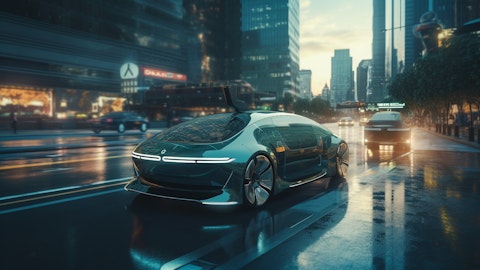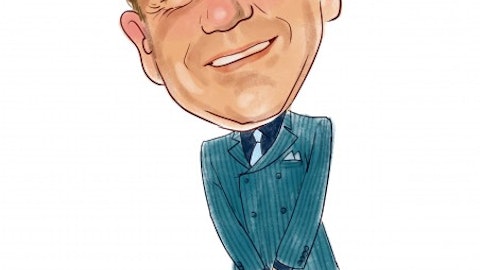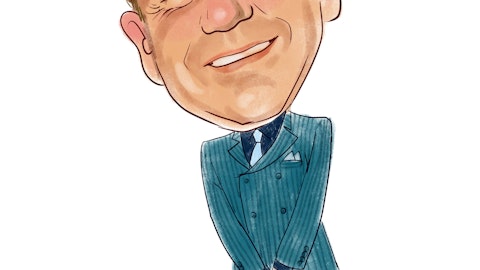And this is what we see in our engagements with OEMs. And this is, for us, really kind of changes the way we’re looking into base ADAS in the future, because we actually think it will potentially diverge to two streams. One will continue to be low-end, front-camera only, just to meet from the lowest cost possible with regulation. And in addition to that, we see a growing demand for SuperVision light as the next generation for the base data segment, let’s say. So it’s kind of an extension and lives — it coexists next to the SuperVision. That’s what I was looking for.
Amnon Shashua: Yeah. And just to clarify, most of the engagement or the vast majority of the engagements are including discussions around multiple of these products, right, just like the Volkswagen Group define.
Tom Narayan: Got it. Thanks.
Operator: Our next question comes from Dan Levy with Barclays. Please proceed with your question.
Dan Levy: Hi. Good morning. Thank you for taking my question. I wanted to start with a question on Volkswagen. Now, that’s more publicly known. So maybe you could just give us a little more on the parameters of the program, what the software versus hardware component homicides actually using your domain controller, what’s the extent of the functionality that’s going to be enabled the regional split? And then in the release, I think there was some commentary that at some point, VW would eventually use in-house solutions. Maybe you could just comment on, I guess, the stickiness of your agreement with them? Or is this maybe a bridge solution for that?
Amnon Shashua: So in terms of the parameters of the deal with the Volkswagen Group, Mobileye is the position of a Tier 1 supplier. So we’re responsible end-to-end for the hardware, and we have other Tier 2 suppliers working with us, for example, for the parking systems. So we are a full Tier 1 supplier. I don’t expect us to be a full, Tier 1 suppliers and many additional programs. But for this program, we are a, full Tier 1 suppliers. So we are responsible for the progress end-to-end. And that includes the perception in terms of software, the perception, the driving policy, the control, there’s a DXP component to fine tune and customize the driving experience to each brand. In terms of the comment about them at some point, moving to an in-house development, I think that’s what they’ve — that was on the table for many, many years.
They have a Software Division called CARIAD and that software division is still in operation, in full force. And at that point, maybe they will be able to deliver the kind of system that we deliver, but we believe that the stickiness of our systems are very, very, very strong. The validation required to reach the very high-levels of the performance of SuperVision are enormous. Stabilization required for eyes-off is beyond anything that the industry has experienced so far. So, I believe the stickiness is very strong. Do you have a–
Nimrod Nehushtan: Yes, if I may add a little bit more color. First of all, the partnership we announced includes SuperVision, Chauffeur, and Drive, as Amnon mentioned, and it’s going to be deployed overall in 17 car models, and it includes most of the brands in the Volkswagen Group, the premium brands, Audi, Porsche, Bentley, Lamborghini, and so on. But just to maybe sharpen the stickiness aspect, this partnership addresses the existing architecture or the next-generation architecture that Volkswagen plan to launch 2026 onwards. And there is kind of a plan to deploy specific car models that are allocated today with this product for many years to come after they started production. Their in-house activity that still exists today is for a future architecture that maybe in some point in time will mature.
It includes many other things that they’re working on, but it’s not that it will replace our product in case it will mature. It will live in a different architecture in different cars, some parts in the future in case did materialize. So, in terms of the stickiness once it reaches production, many, many cars that are — will be deployed with this for many years after this year’s production.
Dan Levy: Great. Thank you. And then as a follow-up, I wanted to go to some of your China commentary. And I think just some time ago, you noted that ZEEKR was offering free 12-month trial of highway SuperVision. I don’t know if you could provide any feedback. But is there any way to get a sense of what the take rate is going to be in the future of this functionality? Is this something where you have confidence that this could be a fairly high take rate or we can maybe standard fit throughout the ZEEKR lineup or [indiscernible]?
Amnon Shashua: We are in discussions with ZEEKR to make it really a standard fit rather than a take rate type of functionality because of the rising competition in China. I believe the convergence will be that it will be standard fit.
Dan Levy: Thank you.
Operator: Our next question comes from Samik Chatterjee with JPMorgan. Please proceed with your question.
Joe Cardoso: Hi, thanks for the question. This is Joe Cardoso on for Samik. Maybe a follow-up on the OEM engagements myself. You guys have shown good progress moving from three to 14 OEMs now, production now covering 46% versus 9% a year ago. Just curious, when you think of the headroom that you have left to go after, like how would you characterize it? And has your views relative to, let’s call it, a ceiling change relative to six, nine months ago or even a year ago, given the developments in the ecosystem and now that you’re approaching 50% of production, at least in kind of the engagements that you have already under your peripherals? Thank you.
Nimrod Nehushtan: Yes. I think that there is a flywheel effect that we’re seeing in which the more we have engagements with OEMs and the more we announced partnership with OEMs, the more — it builds our credibility on these advanced product line. And we are also more prepared today, let’s say, in terms of our business development activities and supporting 14 engagements in parallel, and we have the capacity to support this and we have the capacity to support even more than this. What happened last year are multiple factors Amnon laid out at the beginning. Number one competition in China and also outside of China is moving towards this hands-off as the next differentiators for cars. Number two, we build our credibility, more announcements kind of helps us to reinforce our position as leaders in this front.
And I think, we know more today about what needs to be done in order to secure these engagements after a year-long negotiation with one of the biggest car companies in the world. So, I think this is what stands behind this increase. And also, this is kind of the adoption curve where today, what’s interesting as Dan mentioned, is that we are working with kind of the early majority and the middle of the pack back of OEM, not just the innovators of the market today on these engagements, which kind of shows us that in ’26, ’27 time frame, these hand-off products will become very available in terms of the amount of OEMs to launch them.
Joe Cardoso: And then maybe just a quick follow-up. Just one — or my second question rather. I just wanted to touch on the destocking situation. It sounds like you’ve made great progress. Can you just talk to maybe some of the changes or processes that you have put into place to improve your visibility around inventory at your customers and how they’re tracking are working today? Thanks for the question.
Moran Shemesh: Yes. So I think we actually discussed it in the last call that this is a situation that we haven’t experienced before. So we did put some processes in place. For this year, I can say, for Q1, we actually based on global production, actual production and ADAS fitment rates, production per OEM, we’ve actually analyzed the gap between what we actually shipped in Q1 and what we would expect to ship if we didn’t have the inventory issue. And that gives us kind of the comfort and also looked, of course, the year-over-year growth to see that it makes sense. We did the same exercise for the full year, so for the full year, taking again the expected lower volume, which looks pretty good. So it’s increasing for our top customers.
Looking at Q3, Q4 and the outcome that we get compared to our customers’ order indications for Q3, Q4, we get to approximately similar numbers, which is encouraging in that aspect. So it’s a step-down analysis versus other indications. In terms of receiving data or some visibility for our customers, we get some verification from them, but only indication, not something — we don’t have full visibility to that. But with the process we have in place with the top down, we can, again, verify the data that we received and have actually a comparison between the two to make sure we are aligned with escalation
Operator: Our next question comes from Ananda Baruah with Loop Capital Markets. Please proceed with your question.
Ananda Baruah: Hey guys. Thanks for taking the question. Just two quick clarifications for me, if I could. The first was, you guys commented on expecting mix to normalize into the second half of the year. And I guess, the clarification is, is it back to mid-single-digit SuperVision or look something different sort of given the SuperVision ramp? And then I have a quick clarification follow-up as well. Thanks.
Amnon Shashua: I think the issue that we had with inventory is not related to SuperVision, related to the EyeQ. SuperVision is on track. This quarter was the volume we shipped 39,000 was above expectation, but we believe that the number for the first half of the year would follow our guidance, which is about 70,000. And the full guidance of the year, we have the remaining second half is according to the guidance we gave at the beginning of the year.
Ananda Baruah: And then for the second clarification is around ASP. I heard — and this may just be me is this hearing what we said or not hearing completely. But I heard on the one hand, ASP for 2024 being $55, up to 2023. And then I thought I also heard another comment about 2024 ASP being down year-over-year. So…
Moran Shemesh: Yes. So the 55 versus 53, that takes into account the mix of SuperVision and EyeQ. So SuperVision of course with a higher ASP, as we are also – the vendor for the hardware. So the ASP is significantly higher. And again, overall ASP of 53 or 55 in 2024, is mainly driven by the mix of SuperVision revenue as a percentage of the total revenue. Again, it’s much higher in the segment. As for EyeQ and ASP and that was my comment, the EyeQ, ASP – yes, the EyeQ ASP was lower in Q1 specifically. We don’t believe this is — this ASP represents the normal ASP for this year. And for Q1, we shipped only 3.5 million chips. So the mix is obviously has changed. So for example, if some of the low cost programs in China became a higher percentage out of these 3.5 million chips, then the ASP is lower.




